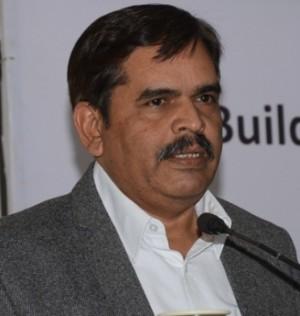‘When the masses are deprived of the benefits of growth, how can it be growth itself?’
‘You cannot sustain growth without equality and employment’
‘After all, when China comes down, India has to rise’

Ever since it was reported that India’s GDP growth has slumped to a 3-year low at 5.7%, the Narendra Modi government has been attacked from all sides.
Now, the Swadeshi Jaagran Manch has decided to screen a three-minute short film warning viewers India is going to be a Chinese ‘colony’ soon.
 Dr Ashwani Mahajan, left, all India co-convenor of the Swadesh Jaagran Manch and an associate professor at the Delhi University, discusses the state of the Indian economy in an interview with Rediff.com’s Shobha Warrier.
Dr Ashwani Mahajan, left, all India co-convenor of the Swadesh Jaagran Manch and an associate professor at the Delhi University, discusses the state of the Indian economy in an interview with Rediff.com’s Shobha Warrier.
GDP growth has hit a 3-year low at 5.7% in the June quarter. Everybody has suddenly started criticising the economic policies of the Modi government now. In what way can the economy be revived, according to Swadeshi Jaagran Manch?
We look at it this way. The 5.7% growth is partly because of the temporary disruption in production and sales due to the introduction of GST. Even before the introduction of GST, many factories were closed because people didn’t know how it was going to impact them. So, it’s partially because of this that the economy has slowed down.
The irony of the situation is that we are all the time talking about the GDP growth, and not the welfare of the people. The latest article by the well-known economist Thomas Picketty is about the inequalities that exist in India. He wrote quoting various data that from the 1980s, the top 1% of the population cornered as much as 22% of the national income. He also wrote that the top 1% of earners captured less than 21% of total income in the late 1930s, before dropping to 6% in the early 1980s and rising to 22% today.
He further wrote that ‘Shining India’ corresponds to the top 10% of the population (about 80 million adult individuals in 2014) rather than the middle 40%. Relatively speaking, the shining decades for the middle 40% group corresponded to the 1951-1980 period, when this group captured a much higher share of total growth (49%) than it did over the past forty years.
Also, since the early 1980s, growth has been highly unevenly distributed within the top 10% group. It means that almost 90% of the population has not gained much in the last 37 years.
If you look at the rural-urban distribution of per capita income, you will see that urban income is nine times more than the rural income.
These kinds of inequalities are due to too much of profiteering by the capitalist class and also due to non-creation of jobs. It has been a jobless growth.
This is the complaint everybody has even today; that it has been a jobless growth even when the economy was growing at more than 7%....
Just saying that it’s a jobless growth is not enough. But when you look at it from the point of view of the economy from 1980-2014 or 1991-2016, you will see a whole generation of Indians have been out of the job market.
What kind of growth are you talking about when 90% of the population is out of the growth? With 1% of the population cornering 22% of national income, how can you sell more cars, scooters or houses?
To sustain development, you need demand and demand comes from the masses. When the masses are deprived of the benefits of growth, how can it be growth itself?
Narendra Modi came to power promising jobs and development. Do you feel whatever that has happening for the last 30 years, still continues?
It is not that he has not taken efforts. Through Jan Dhan Yojana, Mudra Yojana, Make in India, Start-Up India, making subsidies reach people, etc, he has tried to save what was being leaked and corned by the middle men.
The fact is, it will take time to get the fruits of all these efforts.
The basic opposition of Swadeshi Jaagran Manch which we have time and again pointed out is that the policy-makers, those at the helm of affairs were those who have the conviction that it was not necessary to connect employment and equality.
If you see the literature produced by Arvind Panagariyaji along with Jagdish Bhagwati, you will see them saying that we need not think about poverty, as poverty will be automatically taken care of if there is growth.
Our advice to the government is, go to the archives of the Planning Commission and find the report made in 2002 by S P Gupta who was a member of the Planning Commission during Atalji’s period. The report, name of which is ‘Creating 10 million jobs per year’, suggested the areas that can create employment. The government should now look at those areas that can create employment.
The trickling down they have been talking about from 1991 has not happened till today….
Yes. The followers of the percolation theory cannot think of equality beyond GDP growth.
But what we, the ideologues of the Swadeshi Jaagran Manch, RSS and the BJP are saying is, the model to be followed is Deen Dayal Upadhyay’s Integral Humanism in letter and spirit.
According to him and also Dattopant Thengdi, when you think of growth, you have to think of employment and improving the lives of the masses also. You have to also think of providing them with health, education and improving their standard of living.
You cannot sustain growth without equality and employment.
So what is the advice of Swadeshi Jagran Manch to Modi Sarkar?
Our advice to the government is, go to the archives of the Planning Commission and find the report made in 2002 by S P Gupta who was a member of the Planning Commission during Atalji’s period. The report, name of which is ‘Creating 10 million jobs per year’, suggested the areas that can create employment. The government should now look at those areas that can create employment.
You mean in the small-scale sector, the unorganised sector?
Exactly. The government has been giving lakhs and crores of rupees as concession to the corporates. As per the last publication, the government has stopped releasing the data now, around Rs 5 lakh crores were given to the corporates in terms of tax concession to promote investment, investment that does not produce any employment.
We see that when a big factory provides employment to 100 people, a small factory may provide jobs to 500 people.
When you can give concession and subsidies for investment, why can’t we subsidise to create more jobs? If a person is given concession or subsidy for employing more people, he will be encouraged to do so.
In the last five years, the share of wages has come down from 78 to 41% while the share of profits has increased from 19% to 57%. Think of the inequality that has been created. So, you have to integrate growth, employment and distribution.
A film made by the Swadeshi Jaagran Manch says the way things are going, India will soon be a colony of China. Are you not being quite critical of the Modi government’s handling of the economy?
You cannot say that we are being harsh on the Modi government. China has been entering the Indian market in a big way for the last 18-19 years utilising the rules of the WTO. Trade with China has increased from less than $1 billion in 1997-98 to $61.7 billion in 2015-16. It has come down marginally in the last one year.
Not only with India, China is at trade war with everybody -- with the US, Europe, and many other countries. In fact, China has a trade surplus with around 90 countries. Because of this, Indian industries are hit, American industries are hit, European industries are hit and this has led to huge unemployment in all these countries.
In most of the European countries, unemployment has reached more than 50%, and the OECD (Organisation for Economic Co-operation and Development) records show that it is 30% in India. This is a cause for concern.
What China is doing now is, they are using the surplus which they have amassed over the years in exchange, to capture the local industries and infrastructure. For example, the bid by the Chinese pharmaceutical company Shanghai Fosun Pharmaceutical Group Co to take over the Indian company Gland Pharma which makes vaccines. We do not want our public health to be controlled by Chinese companies.
These are short-term disruptions and the economy will be able to overcome all these in the next one or two quarters. According to us, that is not the real issue. What we need is sustained growth, sustained development and improvement in the human development index. That is possible only if you think of the last man in the queue.
So, we made the film to make people aware of what is in store for us in future. It is also aimed at the policy-makers and the media. We have dramatised a little bit to create an impact. It doesn’t mean that we are going to be a Chinese colony soon! Yes, it depicts the concern Swadeshi Jaagran Manch has about welcoming all kinds of foreign investment.
We want policy-makers and people to take some corrective measures so that China is not able to control our industry and economy.
Do you feel by showing the film at various public places, you will be able to change the mindset of the people from buying cheap Chinese goods?
Definitely. Our aim is to make people aware of the threat Chinese products are creating in this nation. This is the second boycott movement after the one against British goods during the independence struggle.
We feel people have taken our call very seriously. That’s why the Chinese are feeling the heat. As per the data available with us, orders to import Chinese goods have come down by 50%. The way the Chinese are reacting to it shows something positive is happening here.
Do you think the government is aware of this and taking positive steps to reduce Chinese imports?
We may not agree with many of the economic policies of the government but we are happy the government is taking some corrective measures by imposing anti-dumping duties on many Chinese goods. Till now, there was anti-dumping duty on 90 items and the government has added tyres also now. In the process are including another 40 items.
China captures the markets by selling things at a price lower than the market price in their own country, which makes countries like India to force anti-dumping duty on Chinese products.
India is also imposing standards on the goods imported.
Under Rule 153 of the General Financial Rules (GFR), the government is giving preference to domestic procurement. When the government procures from the market, it is giving 20% preference to Indian goods.
All these three policies are made to put a stop on the import of Chinese goods. So, we are on the same page with the government in reducing the import of Chinese goods.
But as far as investments are concerned, we are trying to make the government realise that investments are more harmful than imports. Through investments, China will get a foothold in the Indian market directly.
Do you think by 2019, the disruptions will go and Narendra Modi will be able to face people with some positive results?
I firmly believe that these are short-term disruptions and the economy will be able to overcome all these in the next one or two quarters.
According to us, that is not the real issue. What we need is sustained growth, sustained development and improvement in the human development index. That is possible only if you think of the last man in the queue.
But I have faith in this government and its policies. After all, when China comes down, India has to rise.
Photograph: Reuters.










